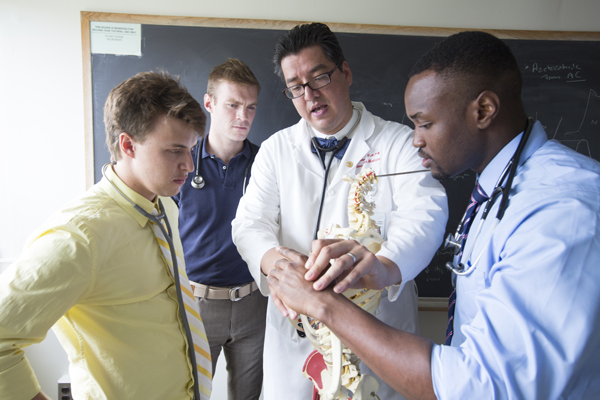
The new curriculum fosters problem solving and lifelong learning. Image: Rose Lincoln/Harvard Staff Photographer
After more than three years of planning, preparation and pilot programs, Harvard Medical School is launching a new medical education curriculum with the incoming Class of 2019.
The curriculum, known as Pathways, is a complete structural and pedagogical redesign of the previous curriculum, according to HMS medical education leaders. It incorporates new modes of teaching and learning that foster problem solving and critical thinking in different ways.
Students will have an earlier clinical experience and longer-term relationships with patients, colleagues and communities. The third and fourth years of the curriculum feature advanced research and clinical experiences and science courses customizable to the needs of individual students.
“The HMS community is committed to providing the best possible education, research and service opportunities for our students, so that they can provide the maximum benefit to their patients and to the world,” said Ed Hundert, Daniel D. Federman, M.D. Professor in Residence of Global Health and Social Medicine and Medical Education and HMS Dean for Medical Education.
“When our faculty and students developed Pathways, we challenged ourselves to imagine the best possible curriculum to take advantage of recent advances in the science and technology of learning, and to prepare our students for the rapidly evolving world of biomedicine where they will spend their careers,” he added.
First-year Pathways students will be taught the core scientific and professional concepts they will need to succeed in their second-year clinical clerkships. The Principal Clinical Experience will now occur seven months earlier in the program. This will make room in the third and fourth years for students to engage in focused, advanced studies and research, taking advantage of the perspective they will have gained through their intense clinical work in the second year.
Learn more about Pathway’s innovative educational techniques. Video by Rick GroleauThe other medical education curricula at HMS — including the Harvard-MIT Health Sciences and Technology (HST) MD program and the medical education component of the Harvard School of Dental Medicine program — are also incorporating innovations at the heart of Pathways curriculum, taking advantage of shifting schedules and new technologies to create updated courses within their own tracks.
Going forward, students in clinics and classrooms will interact with one another in different ways. At various points in their journey through HMS, for example, some students will have more clinical experiences and others will delve deeper into science.
“This diversity of perspectives is a great opportunity for students to mentor one another,” Hundert said, “both because part of doctoring is being able to teach junior colleagues, and because people learn particularly well from their near peers.”
New ways of teaching and learning
The core preclinical classes in the new curriculum flip the traditional model of education upside down: instead of professors lecturing facts and information to classes, the new approach provides resources such as brief concept videos that help students absorb basic information before coming to class. Then, during class time, students can apply that information as they work in small groups to solve problems, with faculty leading discussions that explore the deeper principles behind the core content.
The program will take advantage of newly renovated teaching facilities in the Medical Education Center (TMEC), which use the latest technologies and which feature flexible physical spaces that facilitate collaborative learning and group discussions.
“Instead of trying to find ways to fit a few innovations into the old curriculum—or the old classrooms—the community came together to envision a whole new way of learning medicine,” said Jane Neill, associate dean for medical education planning and administration.
Next steps
Although the curriculum is ready, there are still many opportunities for new ideas and improvement, Hundert and Neill said, including the possibility of creating advanced integrated science classes and research opportunities for third- and fourth-year students.
For example, Michael Greenberg, the Nathan Marsh Pusey Professor of Neurobiology and head of the Department of Neurobiology at HMS, is collaborating with the chairs of the neurology departments at the School’s affiliated hospitals to develop a new course in human development that will connect advances in neuroscience and neuromedicine.
Hundert and Neill also noted that a series of evaluation processes have been built into Pathways, which will allow educators to make sure that the new curriculum is effective, and which will also guide students in their efforts to navigate the curriculum.
“A good curriculum is never finished,” Hundert said. “Given the extraordinary talent of our students, we owe it to them, to their patients and to the world to build continuous improvement into everything we do. I am inspired daily by our faculty’s commitment to teaching excellence and their dedication to our students.”


